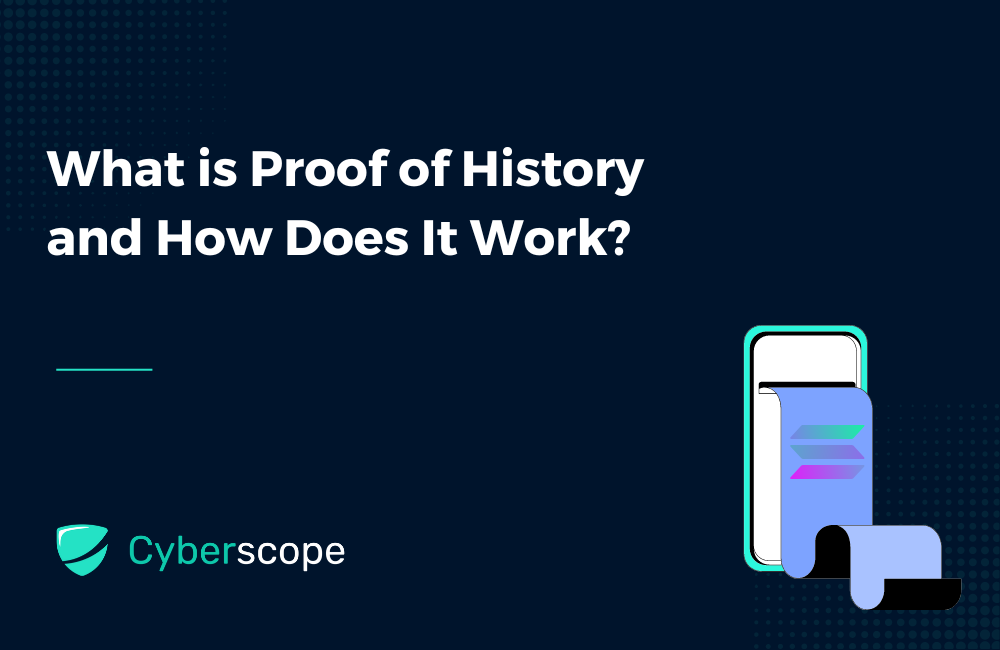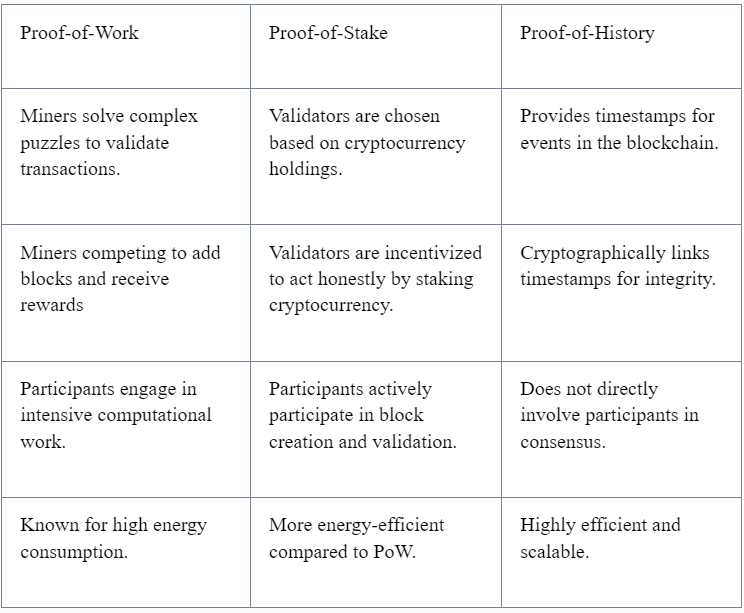

What is Proof of History and How Does It Work?

Intro
The search for faster, safer, and more decentralized blockchain systems is never-ending. Proof of History (PoH) steps into this arena as a fresh idea, brought to life by the Solana blockchain platform. PoH operates as a formidable guardian of timekeeping within the digital landscape, employing sophisticated methodologies to optimize transactional efficiency and ensure steadfast reliability.
PoH works by stamping each transaction with a time marker, ensuring everything happens in the right order. But it's not just any stamp; it's super-efficient, thanks to Solana's clever design. This means transactions zip through faster, saving time and energy compared to older methods like Proof of Work or Proof of Stake.
But PoH isn't just about speed. Its transparency and reliability make it a game-changer for all kinds of applications, from finance to supply chain management. By creating an unbreakable chain of time-stamped events, PoH builds trust and opens up new possibilities for innovation.
Of course, there are challenges ahead. Keeping PoH networks decentralized, making sure they can talk to other blockchains, and staying ahead of security threats are all crucial. However, with ongoing research and development, PoH has the potential to revolutionize the way we think about digital transactions and identities.
In short, Proof of History is like a breath of fresh air in the blockchain world, bringing speed, security, and decentralization to the forefront. As it continues to evolve, its impact on our digital lives is sure to be profound.
What is Solana?
Solana is a blockchain network that's gaining attention for its unique approach to consensus called Proof of History, combined with Proof of Stake. It's like Bitcoin and Ethereum but with its twist. It uses its native token called Sol.
One key feature of Solana is its ability to support layer 2 networks, allowing developers to build on top of it. Similar to Ethereum, it also enables smart contracts and interaction with decentralized applications (dApps).
Solana is seen as a strong competitor to Ethereum due to its innovative blockchain architecture. Learning about Solana is important because it offers a robust environment for building applications directly on the blockchain. For example, in 2022, Solana saw over 5,000 new NFT protocols introduced, showcasing its potential for on-chain application development.
What is Proof of History?
Proof of History (PoH) stands out as a groundbreaking consensus mechanism pioneered by Anatoly Yakovenko, the driving force behind Solana Labs. PoH operates on the principle that within a blockchain ecosystem, the order of events is just as critical as the events themselves, and verifying this order is fundamental for upholding the network's integrity. To achieve this, PoH harnesses the power of a Verifiable Delay Function (VDF) to generate a timestamp for each block within the blockchain.
What truly distinguishes PoH is its role as the custodian of truth and transparency within the blockchain ecosystem. It affords all participants a glimpse into the inner workings, facilitating the verification of transactions and events without necessitating the presence of a centralized arbiter. Such transparency fosters a foundation of trust within the network.
Primarily employed within the Solana blockchain network, PoH is meticulously designed for superior scalability, capable of processing thousands of transactions per second. By minimizing the need for extensive storage and bandwidth for maintaining the blockchain, PoH elevates the efficiency and velocity of the Solana network while simultaneously guaranteeing a secure and verifiable transaction history.
Therefore, when encountering discussions surrounding PoH, it's essential to recognize it as more than a mere acronym – it stands as the guardian of integrity, ensuring the safety, reliability, and dynamism of blockchain transactions.

How Does Proof of History Work?
Proof of History (PoH) is the secret sauce that keeps the blockchain world ticking. It's like having a super-reliable clock that timestamps every single thing that happens in the blockchain universe. But how exactly does this fancy timekeeper work? Let's break it down into simple terms:
- Timekeeping Magic: Proof of History (PoH) operates by affixing a timestamp to every action occurring within the blockchain. Whether you're transferring cryptocurrency to a friend or executing a smart contract, PoH guarantees that each event receives its distinct timestamp.
- Building Blocks: These timestamps aren't just scattered about randomly. Instead, they're cleverly linked together, one after the other. This linking is what keeps the whole system in order and prevents anyone from sneaking in and rearranging things.
- Promoting Consensus: Proof of History (PoH) serves as a crucial solution in blockchain networks by establishing consensus on the precise sequence of events. This systematic approach ensures streamlined operations and minimizes confusion among participants. With PoH, the blockchain ecosystem maintains order and efficiency, facilitating the smooth execution of processes.
- Efficiency in Action: In the blockchain realm, PoH exhibits remarkable agility, swiftly processing transactions and effortlessly managing high volumes of activity on the blockchain.
- Seeing Is Believing: One of the key advantages of PoH is its transparency. Individuals can easily inspect the timestamps, ensuring that all transactions are conducted in a fair and transparent manner.
So there you have it – PoH is keeping everything running smoothly behind the scenes. It's the reason you can send crypto halfway around the world in the blink of an eye, and it's the backbone of a system that's changing the way we think about money and technology.
See also: 10 Tips for Securing Your Crypto Wallet
Advantages of Proof of History
Proof of History (PoH) brings a multitude of advantages to the table, making it a game-changer in the world of blockchain technology. Here are some of its key benefits:
- Scalability: PoH significantly enhances the scalability of blockchain networks by enabling high throughput without compromising on security or decentralization. Its efficient timestamping mechanism allows for the quick processing of a large number of transactions, making it ideal for applications requiring rapid transaction speeds.
- Efficiency: Unlike traditional consensus mechanisms such as Proof of Work (PoW) or Proof of Stake (PoS), which can be computationally intensive, PoH is designed to be highly efficient. It achieves this by leveraging parallel processing and optimized timestamp generation, resulting in reduced energy consumption and lower transaction fees.
- Security: PoH enhances the security of blockchain networks by providing a verifiable and immutable record of events. Its cryptographic linking of timestamps ensures that the entire history of transactions is tamper-proof and resistant to manipulation. This strengthens trust in the network and mitigates the risk of attacks such as double-spending.
- Transparency: PoH promotes transparency by making the entire transaction history publicly available and independently verifiable by anyone participating in the network. This fosters trust among users and encourages greater adoption of blockchain technology by assuring that transactions are conducted fairly and transparently.
- Reliability: By establishing a reliable and accurate chronological order of events, PoH helps prevent disputes and ensures the integrity of the blockchain. Its robust timestamping mechanism creates a solid foundation for building decentralized applications that require a dependable and trustworthy transaction history.
- Innovation: PoH opens the door to new possibilities in decentralized finance (DeFi), non-fungible tokens (NFTs), and other blockchain-based applications by enabling faster and more efficient transaction processing. Its scalability and efficiency pave the way for innovative use cases that were previously impractical or unfeasible.
Overall, Proof of History offers a compelling array of advantages that address many of the scalability, efficiency, security, and transparency challenges faced by traditional blockchain networks. Its innovative approach to timestamping events sets a new standard for blockchain consensus mechanisms and unlocks exciting opportunities for the future of decentralized technology.
Challenges and Future Directions
While Proof of History (PoH) presents numerous advantages, it's not without its challenges and areas for future improvement. One key challenge lies in ensuring the continued decentralization of blockchain networks implementing PoH. As the network grows and evolves, maintaining a diverse set of validators and preventing centralization of power among a few entities becomes crucial. Additionally, while PoH enhances scalability and efficiency, further research and development are needed to optimize its performance, particularly in highly congested networks or under adversarial conditions.
Moreover, interoperability remains a significant challenge for blockchain ecosystems. As different networks adopt varying consensus mechanisms and protocols, seamless communication and interoperability between them become increasingly important. PoH-based networks must work towards interoperability standards and solutions to enable smooth data transfer and collaboration across heterogeneous blockchain platforms.
Looking ahead, future directions for PoH include exploring enhancements to its security model, such as incorporating advanced cryptographic techniques or integrating with other consensus mechanisms to provide additional layers of defense against attacks. Additionally, advancements in privacy-preserving technologies within PoH-based networks can address concerns surrounding data privacy and confidentiality.
Furthermore, as blockchain technology continues to evolve, PoH may find applications beyond transaction validation, such as in decentralized identity management, supply chain tracking, and decentralized autonomous organizations (DAOs). Research efforts should focus on adapting PoH to meet the unique requirements of these use cases while maintaining its core principles of scalability, efficiency, and security.
How is PoH Different from PoS and PoW?

Conclusion
In summary, Proof of History (PoH) represents a pioneering advancement within the dynamic landscape of blockchain technology. Its efficient timekeeping mechanism offers a compelling solution to the scalability, security, and decentralization challenges that have long plagued traditional consensus mechanisms. PoH's ability to seamlessly order and timestamp transactions opens doors to new possibilities across various industries, promising faster, more reliable, and transparent blockchain networks.
As PoH-based platforms like Solana continue to mature and gain traction, it's essential to address the remaining hurdles, including decentralization, interoperability, and security concerns. With ongoing research and development efforts, PoH has the potential to redefine the way we transact, interact, and trust digital systems.
In the journey towards widespread adoption, PoH represents not just a technological advancement, but a paradigm shift towards a more efficient, secure, and inclusive digital future. As we embrace this transformative technology, the impact of PoH on the blockchain landscape will undoubtedly leave a lasting legacy, shaping the way we live, work, and connect in the digital age.


